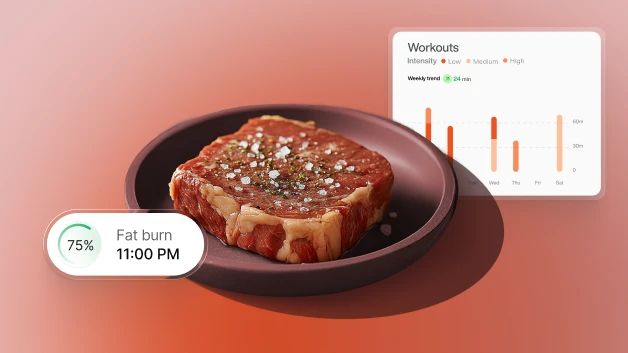Intermittent fasting with Lumen

Intermittent fasting has been in the spotlight and gained popularity over the past few years. In fact, Intermittent fasting was Google’s most-searched diet of 2023 The key to understanding this tool is to understand what is actually going on behind the scenes. Does intermittent fasting really “boost” your metabolism? And how does Lumen incorporate methods of intermittent fasting to optimize your success? Here we delve into this topic and tell you everything you need to know – as well as breakdown how Lumen incorporates these methods into your daily plan for better metabolic health.

Intermittent fasting explained
Intermittent fasting is a method of fasting where you cycle between specific time periods of eating and fasting – consuming little to no calories. The concept isn’t something new and has been around for centuries, but lately it has grown in popularity due to the metabolic benefits and other health habits it promotes. There are many methods of intermittent fasting, so the key is finding one that works for you with your lifestyle.
Types of intermittent fasting
Fasting means consuming zero calories, but with that in mind, there are different types of fasting which include manipulating the timing of meals instead, to train the body how to use the food you consume in a more effective way. The two most common types of intermittent fasting are alternate day fasting (such as 5:2) and time restrictive eating (such as 16:8). The difference between them lies in their daily approach.
Alternate day fasting:
In this method, several days of the week are used as fast days. During these fast days, up to 25% of your daily caloric needs can be consumed, or none depending on the variations. For men this is on average 600 calories, and for women 500. For the remaining days, caloric intake is normal. There are various approaches to alternate day fasting which includes 5:2 – 2 days fasting and 5 days normal caloric consumption, 6:1, or 4:3.
Time restrictive eating
In this method, all of your daily calorie intake is consumed with an 8-10 hour window. These hours are flexible as long as during the remaining 14-16 hours you do not consume more calories. In this method, people generally choose to skip breakfast and begin their 8-10 hour window at around 11am.
How intermittent fasting works:
Insulin, Growth Hormone, and Norepinephrine
Between each meal your body considers itself as fasting (this is of course providing you did not snack and consuming anything between the meals). During this time, insulin levels are reduced, allowing fat cells to release fatty acids which are converted to glycerol (which can be converted to glucose for energy). When our insulin levels are reduced, often the outcome is weight loss. With intermittent fasting, you allow your body to drop insulin levels low enough and for long enough that it assists in shifting you into a fat burning state. For this reason (as well as other benefits of intermittent fasting), Lumen incorporates fasting methods in its recommendations for users to assist in getting your body to a fat burning state when you measure your metabolism each morning.
Fasting can also cause a rise in human growth hormone levels. This hormone is important for promoting fat loss. Studies suggest that during intermittent fasting for women, and men, the human growth hormone tends to be higher. An increase in this hormone is responsible for fat burning, but also muscle mass preservation.
Norepinephrine is another hormone that is impacted by fasting. This stress hormone is responsible for improving alertness and attention. It is also the hormone involved in the “fight or flight” response. Another effect this hormone has on the body is signaling fat cells to release fatty acids. When norepinephrine is high, this leads to a state of short term stress that means more fat being available for your body to burn. When fasting, norepinephrine is raised in the bloodstream.
The benefits of intermittent fasting
Breaking through a weight loss plateau is usually the main driving force for the most recent rise in popularity of intermittent fasting. Evidence suggests by using a sustainable method of fasting around your circadian rhythm, you can benefit yourself in a number of ways beyond weight loss, including these other health benefits:
- A reduced body fat mass
- A reduction in inflammation
- A better lean mass retention
How Lumen Uses Intermittent Fasting
The fasting period that comes with intermittent fasting allows your body plenty of time to process your daily macros, shift your body into a state of fat burn and assists in improving your metabolic flexibility. In essence, intermittent fasting is a tool that assists in enhancing mitochondrial function and increasing insulin sensitivity. Part of Lumen’s method is understanding that intermittent fasting and manipulating the timing of meals, (and carb intake specifically) aids in shifting your body into the state of fat burn. Lumen also provides one-of-a-kind daily metabolic measurements, giving feedback on your method of intermittent fasting and whether or not it is yielding the desired results. Lumen informs you when you are in this fat burning state and supports according to the length of your fast to provide a tool personalized to your metabolism and help you improve your metabolic health.
3 Ways Lumen’s Method Optimizes Your Intermittent Fasting
- Lumen supports fasting based on your metabolism – rather than guessing which intermittent fasting method is best for your metabolism, Lumen’s data shows you what your body needs based on your real-time measurements each day.
- Lumen shows you the results – Lumen provides daily feedback on the impact of your fast and how your metabolism is adjusting to your preferred method of fasting.
- Lumen provides balance – Rather than overeating after a fast, which sometimes occurs, Lumen helps provide nutritional balance to reduce cravings and keep you informed on what to do next.
Doing what’s best for you
When done right, intermittent fasting can serve as a powerful tool for metabolic health and weight loss. It also has a protective effect against metabolic diseases such as obesity and diabetes.
Research shows that short-term fasts can also speed up metabolic processes and prevent the loss of muscle mass. When it comes to deciding which method of intermittent fasting is best, each person should follow a fasting routine based on their needs. What works best for one person might be different for another.
Lumen recommends a specific type of intermittent fasting: time restrictive eating. Restricting your food intake to a specific “eating window”’ has multiple benefits in health, which has been proven to lead to better health results than eating the biggest meal of the day at night.
But more than anything, it is important to remember that this is not a “one size fits all” and it should be adapted to your needs and lifestyle.
Visit our Intermittent Fasting category, to learn more about how it contributes to healthy metabolism and its impact on sustainable weight loss







 Digital download
Digital download 


